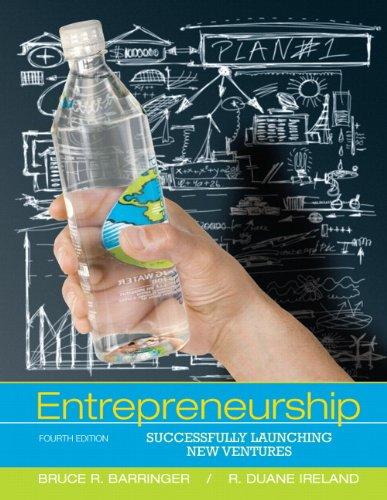Bill Gross is both a serial entrepreneur and the founder of Idealab, an incubator-type organization that has
Question:
Bill Gross is both a serial entrepreneur and the founder of Idealab, an incubator-type organization that has launched over 75 companies. He’s also an Internet pioneer and the creator of the pay-per-click model of Internet advertising. In speaking to groups about entrepreneurship and in working with start-ups at Idealab, there is a story that Gross likes to tell about the importance of feasibility analysis and getting close to customers. It’s an experience that has shaped his views about how important it is to learn from the potential users of your product.
In the early 1990s Gross started a software company named Knowledge Adventure. It started by making educational CD-ROM products for children, such as Space Adventure and Dinosaur Adventure. The firm also launched a line of products under the JumpStart brand.
These products help kids with topics they encounter in school, such as math and science.
One Christmas, in the early 1990s, Gross really wanted his company to excel, so he decided to have employees spend weekends in places where Knowledge Adventure products were sold, to demo the products to parents and hopefully boost sales. So the company’s 65 employees took turns traveling to electronics stores where they would set up booths at the end of aisles to demo their firm’s products. Each Monday, following a weekend when employees were in stores, the employees met to talk about their experiences. One interesting theme emerged from these meetings. When looking at educational software products, parents were often confused about whether a particular product was ageappropriate for their child. They would often look at the back of the box (software was sold on CDs in boxes in those days), look at their child, look back at the box, and appear puzzled about whether the software was a good match for their child. Many companies, Knowledge Adventure included, would put wide age ranges on their products to broaden their appeal. Apparently, this practice inadvertently caused parents to wonder whether a product with a wide age range was really a good match for their particular child.
Thinking through what the employees had observed, Gross and his team came up with a novel idea. What if they produced educational software products that were targeted for a specific grade—like one for preschoolers, one for kindergarteners, one for first grade students, and so forth, to try to avoid confusion for parents. Gross remembers that there was a big fight in his company over this idea. The sales force said, “We can’t convince stores to sell software for one age group. They’ll never sell enough product.” After listening to all the arguments, Gross concluded it was worth a try. So Knowledge Adventure created JumpStart Pre-School and JumpStart Kindergarten to test the concept. The result: The products sold 20 to 50 times the company’s other products.
Parents loved it—now they knew exactly what product was right for their child. There was even an aspirational quality to the products. Parents would see a product like JumpStart Kindergarten and buy it for their preschool child hoping to give them a head start in kindergarten.
Knowledge Adventure has sold over 20 million copies of its grade-specific JumpStart products, and they are still for sale today.
What Gross likes to emphasize when telling this story is that he and his team would have never discovered the confusion that parents had in trying to determine if particular software products were age-appropriate for their children without directly observing them in stores. As a result of this experience, Gross is now a passionate advocate of start-ups directly interacting with potential users of their products.
Questions for Critical Thinking
1. In putting wide age ranges on their products (i.e., suitable for ages 4 through 7), do you think that software companies prior to the advent of JumpStart’s grade-specific products ever thought that the wide age range caused parents angst in trying to determine if a particular product was suitable for their child? If your answer is “no,” how could companies have missed such a fundamental factor? What is the broader implication of this lesson?
2. Could Gross and his team have gleaned the same type of insights they gained via directly observing parents shopping for educational software for their kids through surveys and focus groups? Explain your answer.
3. Design a program for InstyMeds, the subject of the “You Be the VC 3.1” feature, to directly observe its customers use its service. How should InstyMeds go about it? What type of insights might emerge from this initiative?
4. How can a start-up that hasn’t already launched apply the lessons learned from Gross’s experience with JumpStart and grade-specific software products?
Step by Step Answer:

Entrepreneurship Successfully Launching New Ventures
ISBN: 9780132555524
4th Edition
Authors: Bruce R. Barringer, R. Duane Ireland





